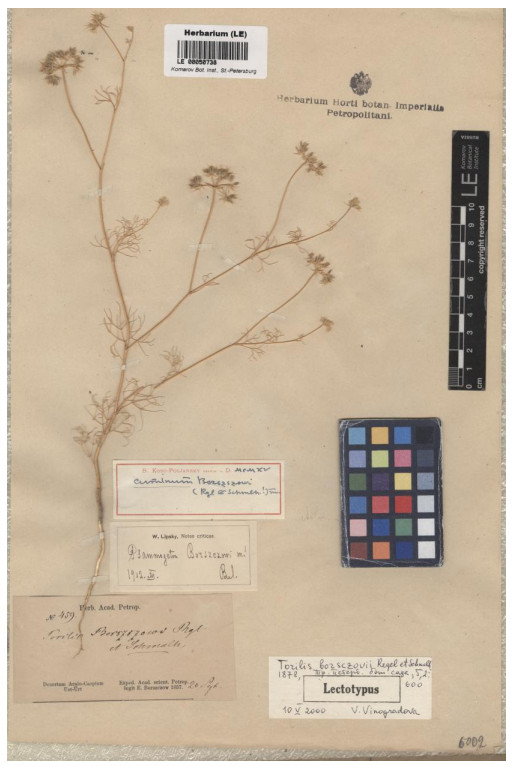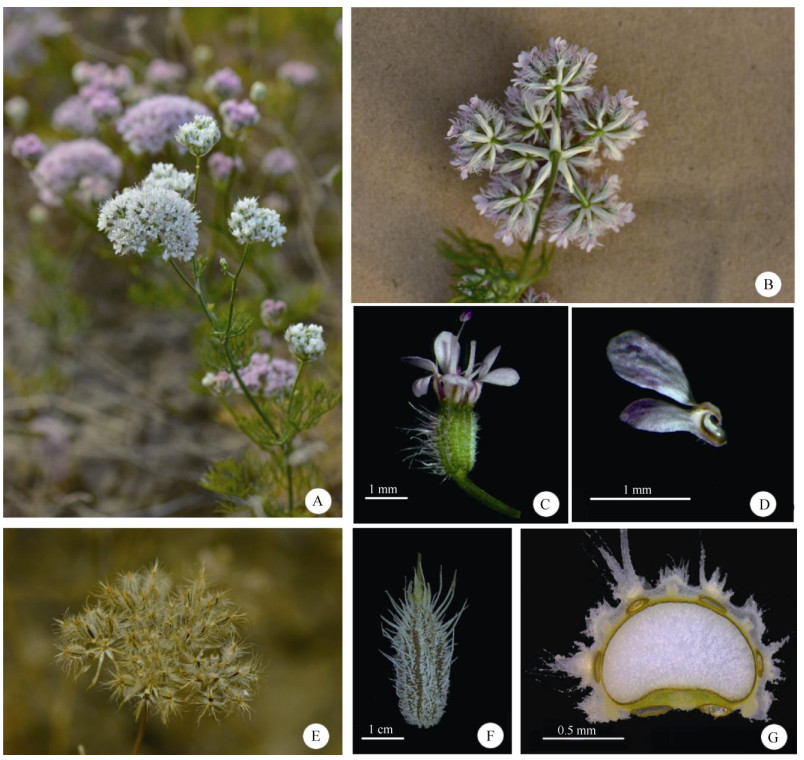2. 中国科学院新疆生态与地理研究所, 干旱区生物地理与生物资源重点实验室, 乌鲁木齐 830011;
3. 杨氏植物标本馆, 乌鲁木齐 830011
2. Key Laboratory of Biogeography and Bioresource in Arid Land, Xinjiang Institute of Ecology and Geography, Chinese Academy of Sciences, Urumqi 830011, China;
3. Yang's Herbarium, Urumqi 830011, China
Apiaceae is a large family with 250-440(-455) genera and more than 3 000 species. It is widely distri- buted in the temperate zone of both hemispheres, mainly in Eurasia and especially in Central Asia. There are about 100 genera and 614 species in China[1].
Cuminum L. (1753: 254) is a small genus of Apiaceae. For a long time, this genus only contained only two species (C. cyminum L. and C. sudanense H. Wolff), which were distributed in the Mediterranean region and Central Asia[2-4]. Cuminum cyminum L. (introduced) is widely cultivated as a spice in China[3-4]. According to the latest information in The Plant List and the Flora of China[1], Cuminum L. now includes four species, of which C. borszczowii (Regel et Schmalh.) Koso-Pol. and C. setifolium (Boiss.) Koso-Pol. have been segregated from Psammogeton Edg (1845: 253).
Psammogeton Edg., a closely related genus of Cuminum L., differs from the latter due to the charac- teristics of its calyx-teeth and mericarps. This genus consists of five species that are mainly distributed in Afghanistan, Central Asia, Iran and Pakistan[2], with no records in China.
During field work in northern Xinjiang, China, in 2017-2018, we collected a species of Apiaceae in the city of Shihezi. It was very close to C. cyminum, but it could not be found in relevant botanical records in China. By observing the morphological characters of plants and specimens, and consulting the literature and specimens at home and abroad, including the type specimens, we have confirmed that the species we found is C. borszxzowii and that this is a new distri- bution record of the species in China.
Cuminum borszczowii (Regel et Schmalh.) Koso-Pol. in Bull. Soc. Imp. Naturalistes Moscou n.s., 29: 209, 1915 [1916]. —— Psammogeton borszczowii (Regel et Schmalh.) Lipsky in Tr. Bot. Sada 23: 144, 1904. —— Torilis borsczowii Rgl. et Schmalh. in Tr. Bot. Sada 5: 600, 1877. Type: Kazakhstan, Aralo- Caspium Ust-Ürt desert, 1857, Borszczow 459 (leco- type LE00050738!) (Fig. 1).

|
Fig. 1 Lectotype sheet of Cuminum borsczowii (Regel et Schmalh.) Koso-Pol. (LE) |
Annual. Root slender, hard. Stem branched from base or middle, 15–35 cm high, glabrous (Fig. 2: A). Leaves nearly sessile or petiolates ca.1 cm long, leaves repeatedly ternate, lobes of last order filiform- linear, 1.5–5 cm long, ca. 0.5 mm wide. Umbels of 5- 12 rays; involucre of 5 wide-lanceolate leaflets with membranous margins (Fig. 2: B), bracts margin ciliate or glabrous, not reflexed, shorter than rays; umbellules 3–8 flowered; pedicels 3–6 mm, stout, very unequal. Calyx teeth lanceolate; 0.5–2 mm, longer than the styles. Petals white, pink or purple (Fig. 2: C), the outer sometimes pubescent, oblong, obtuse, ca. 1.5 mm× 0.7 mm, base with claw (Fig. 2: D); stylopodium short- conical; styles 2, 1.5 mm long. Fruit oblong-ellipsoid, slightly laterally compressed, schizocarp easy to separate (Fig. 2: E), 2.5–5 mm long and 0.5-1 mm short branching hairs; secondary ribs densely covered wide; primary ribs 5, densely covered with white with prickly bristles (Fig. 2: F). Vittae 1 in each furrow under secondary ribs, 2 on commissure. Carpophore 2-parted (Fig. 2: G).

|
Fig. 2 Cuminum borsczowii (Regel et Schmalh.) Koso-Pol. A: Plant; B: Bracts; C: Flower; D: Petal and claw; E: Infructescence; F: Fruit; G: Vittas (Photoed by J. Qiu and Z. Z. Yang). |
Distribution: China (Xinjiang) (new record); Kazakhstan (Atyrau zhylyoi District and Kyzylkum).
Habitat and ecology: Cuminum borszczowii grows in clay deserts and on clayey slopes. It occurs at 790 m a.s.l. Associated species include Lallemantia royleana, Lappula spinocarpos, Ixioiirion tataricum, and Tauscheria lasiocarpa.
Phenology: Flowering from May to June; fruiting from June to July.
Chinese name: chang mao zi ran qin (长毛孜然芹)
Notes: Cuminum borszczowii is similar to C. cyminum, and differs from C. cyminum by having broadly lanceolate bracts, apex acute, undivided, with wide white membranous margins, not reflexed, shorter than rays; mericarps densely covered with irregular long hairs.
Additional specimens examined: Kazakhstan. Atyrau Zhylyoi District (46°29′52.80″ N, 55°49′13.60″ E); Qyzylorda: Syr-Darian deserts & Kyzylkum, Куль- тиасов 199 (MW!), Пименов 132 (MW!), Пименов 128 (MW!), Клюйков 497 (MW!); Caspian Ustyurt & Northern Aralia, Востокова (MW!), Черкасова 474 (MW!); Muyunkumy, Balkhash & Betpak-Dala, Шипчинский 39 (MW!), Липшиц 128Aa (MW!).
AcknowledgmentsWe thank Dr. Carol C. Baskin and Dr. Jerry M. Baskin (University of Kentucky, Lexington, Kentucky, USA) for correcting the English, and grateful to Dr. Huimin Li (University of Chinese Academy of Sciences, China) for her assistance in searching for relevant literature. We also thank the curators of LE for allowing us to use their images of specimens.
| [1] |
PU F T, WATSON M F. Cuminum L.[M]//WU Z Y, RAVEN P H, HONG D Y. Flora of China, Vol. 14. Beijing: Science Press & St. Louis: Missouri Botanical Garden Press, 2005: 75-76.
|
| [2] |
SHISHKIN B K. Psammogeton Edg.[M]//SHISHKIN B K. Flora of the U.S.S.R., Vol. 16. New York: Science Publishers, 1973: 119-121.
|
| [3] |
SHAN R H, SHEH M L. Flora Reipublicae Popularis Sinicae, Tomus 55(2)[M]. Beijing: Science Press, 1985: 4-6. (in Chinese).
|
| [4] |
SHEN K M. Cuminum L.[M]//SHEN K M. Flora Xinjiangensis, Vol. 3. Urümqi: Xinjiang Science & Technology Publishing House, 2011: 506. (in Chinese)
|
 2020, Vol. 28
2020, Vol. 28


